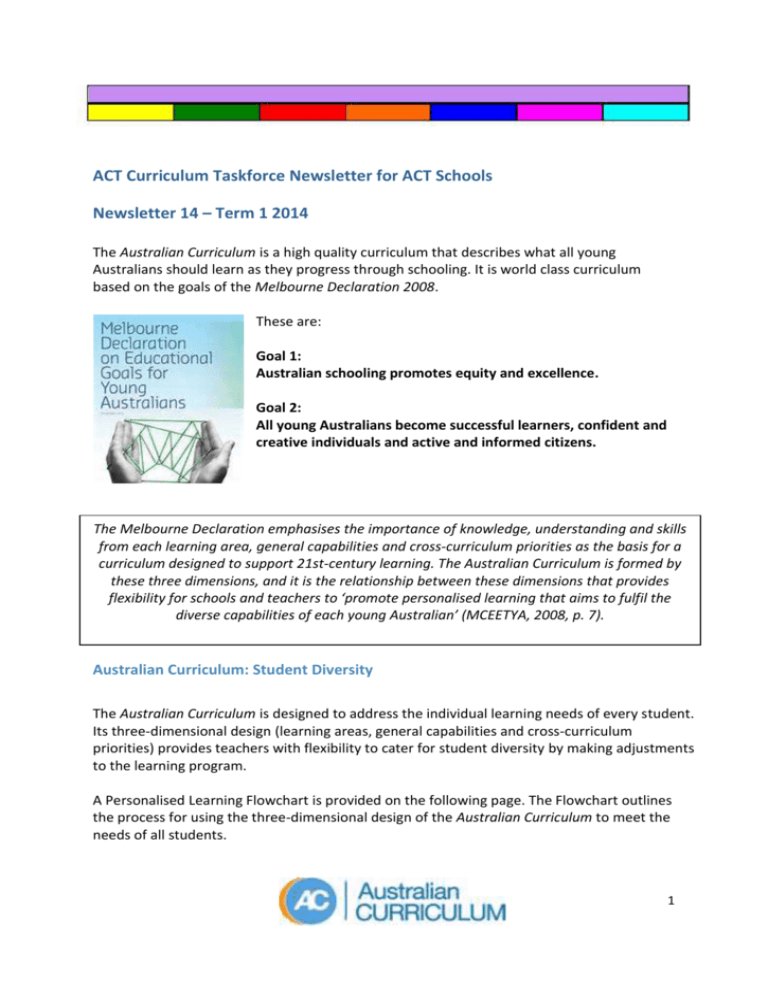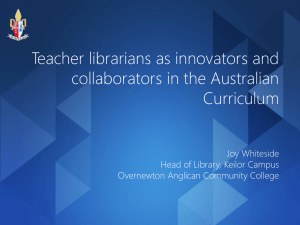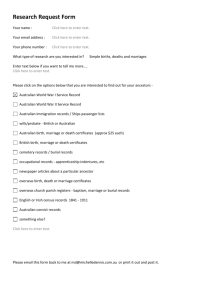Newsletter 14, Term 1, 2014
advertisement

ACT Curriculum Taskforce Newsletter for ACT Schools Newsletter 14 – Term 1 2014 The Australian Curriculum is a high quality curriculum that describes what all young Australians should learn as they progress through schooling. It is world class curriculum based on the goals of the Melbourne Declaration 2008. These are: Goal 1: Australian schooling promotes equity and excellence. Goal 2: All young Australians become successful learners, confident and creative individuals and active and informed citizens. The Melbourne Declaration emphasises the importance of knowledge, understanding and skills from each learning area, general capabilities and cross-curriculum priorities as the basis for a curriculum designed to support 21st-century learning. The Australian Curriculum is formed by these three dimensions, and it is the relationship between these dimensions that provides flexibility for schools and teachers to ‘promote personalised learning that aims to fulfil the diverse capabilities of each young Australian’ (MCEETYA, 2008, p. 7). Australian Curriculum: Student Diversity The Australian Curriculum is designed to address the individual learning needs of every student. Its three-dimensional design (learning areas, general capabilities and cross-curriculum priorities) provides teachers with flexibility to cater for student diversity by making adjustments to the learning program. A Personalised Learning Flowchart is provided on the following page. The Flowchart outlines the process for using the three-dimensional design of the Australian Curriculum to meet the needs of all students. 1 Personalised Learning Flowchart Using the Australian Curriculum to Meet the Learning Needs of all Students Teachers refer to the Australian Curriculum learning area content that aligns with their students’ chronological age as the starting point in planning teaching and learning programs. Teachers take account of the range of their students’ current levels of learning, strengths, goals and interests, and personalise learning where necessary through adjustments to the teaching and learning program, according to individual learning need, by: drawing from learning area content at different levels along the Foundation to Year 10 sequence to personalise age-equivalent learning area content using the general capabilities and/or cross-curriculum priorities to adjust the learning focus of the age-equivalent learning area content aligning individual learning goals with age-equivalent learning area content Teachers assess students’ progress through the Australian Curriculum in relation to Achievement Standards. Some students’ progress will be assessed in relation to their individual learning goals. Approaches to assessment and reporting will differ across the States and Territories. Source: http://www.australiancurriculum.edu.au/StudentDiversity/Meeting-diverse-learningneeds#flowchart 2 The Australian Curriculum Website: Personalised Learning The Personalised Learning Flowchart and other key resources to support the learning needs of all students can be found under the Student Diversity tab on the Australian Curriculum website. http://www.australiancurriculum.edu.au/StudentDiversity/Student-diversity-advice The advice and resources equip teachers with the necessary information to make curriculum adjustments and personalise learning for students with disability, gifted and talented students and students for whom English is an additional language or dialect. These adjustments support every student’s entitlement to rigorous, relevant and engaging learning experiences across all areas of the curriculum. Students with Disability Schools and teachers have a responsibility to ensure that students with disability are able to participate in the Australian Curriculum on the same basis as their peers through the provision of rigorous, meaningful and dignified learning programs. Students with disability are entitled to: the same opportunities and choices in their education that are available to students without disability rigorous, relevant and engaging learning opportunities based on the Australian Curriculum and set in age-equivalent learning contexts equitable opportunities and choices to access age-equivalent content from all learning areas of the Australian Curriculum learning programs based on their individual learning needs, strengths, goals and interests. Principals and schools can meet their obligations under the Disability Discrimination Act 1992 and Disability Standards for Education 2005 by making adjustments to the learning program to ensure that students with disability have the opportunity to participate in schooling on the same basis as students without disability. Gifted and Talented Students ‘Giftedness’ refers to a student’s outstanding natural abilities or aptitudes in one or more of the following domains: intellectual, creative, social, perceptual or physical. ‘Talent’ is the outstanding performance or competency in one or more fields of human activity. Gifted and talented students are entitled to rigorous, relevant and engaging learning opportunities drawn from the Australian Curriculum and aligned with their individual learning needs, strengths, interests and goals. 3 To meet gifted and talented students’ individual needs, adjustments to the learning program may include some or all of the following elements: faster pace (acceleration) greater breadth (enrichment) more depth (extension). Each of these three elements can be given different emphasis to make the necessary curriculum adjustments. Decisions on the balance of these adjustments should reflect the particular needs of each learner. Students for whom English is an Additional Language or Dialect Students for whom English is an additional language or dialect (EAL/D) are students whose first language is a language other than English and who require additional support to assist them to develop English language proficiency. EAL/D students require specific support to build the English language skills required for effective communication and access to the Australian Curriculum. ACARA has developed the English as an Additional Language or Dialect Teacher Resource to support teachers to develop personalised teaching and learning programs for EAL/D students. This resource has been developed to assist classroom teachers to identify where their EAL/D students are broadly positioned on a progression of English language learning and to provide examples of supportive teaching strategies. Did you know.... ACARA is seeking feedback on a new version of the Australian Curriculum website until the end of June 2014? The new website includes Illustrations of Personalised Learning under the Student Diversity tab. Visit http://beta.australiancurriculum.edu.au/StudentDiversity/Illustrations-ofpersonalised-learning The ACT Curriculum Taskforce was convened to support cross-sectoral implementation of the Australian Curriculum in the ACT. The work of the ACT Curriculum Taskforce is supported by the Australian Curriculum Implementation Committee. 4







